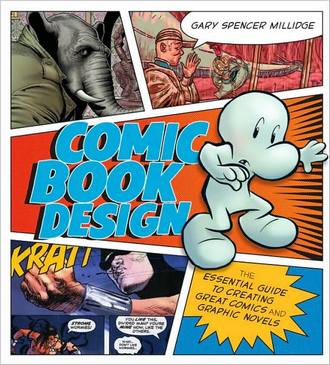- Comics
- Comics Reviews
- Manga
- Comics Reviews
- European Comics
- News
- Comics News
- Press Releases
- Columns
- Spotlight
- Digital Comics
- Webcomics
- Cult Favorite
- Back Issues
- Webcomics
- Movies
- Toys
- Store
- More
- About
By Leroy Douresseaux
July 6, 2009 - 10:26
 |
| Comic Book Design cover image is courtesy of barnesandnoble.com. |
It is likely that most veteran artists, art directors, graphic designers, and even some editors working in comic book publishing are already familiar with the design elements that are specific to comic books. On the other hands, novice and wannabe creators will find the new book, Comic Book Design, to be an indispensable book – perhaps even a bible.
There’s a caption on this book’s cover that declares “The Essential Guide to Creating Comics and Graphic Novels.” With the author, Gary Spencer Millidge, being a creator of an actual comic book series, Strangehaven (which has been on hiatus for the past few years), that caption has some legitimacy because Millidge knows of what he speaks.
Comic Book Design is an analysis and survey of design in comics and graphic novels, and Millidge doesn’t skimp on the analysis or the survey. For this volume’s 160 full-color pages, Millidge presents a diverse range of comic book images and details from the dawn of superhero comic books to recent times. Those images come from comics published in Japan, Europe, and North America, and the book’s 10” x 11” size is a good format for displaying comic book art and sketchbook work, as well as samples of lettering and sound effects.
Millidge has divided Comic Book Design into six chapters, covering design aspects of comic book creation such as “Character and Location Design,” “Page Layout and Design,” and “Covers and Publication Design.” Each of those six chapters is broken into numerous topics – a minimum of 10. For instance, Millidge divides Chapter 2 (“Visual Storytelling and Panel Design”) into such topics as “Writing and Visual Storytelling: Breaking Down the Story,” Varying the Tempo,” and “Camera Angles,” among 19 such topics. Millidge also uses a diverse range of images and details from comic books to illustrate his points.
These images are taken from the comic book work of legends, acknowledged masters, and little-known, but acclaimed talent. There is even behind-the-scenes material such as sketchbook art, character designs, and pages in various stages of completion to show how inks, colors, and letters change the original drawings.
The artists whose work appears in Comic Book Design include Jaime Hernandez, Gilbert Hernandez, Eddie Campell, Alan Davis, Steve Ditko, Dave McKean, Carla Speed McNeil, Frank Miller, Moebius, Kevin O’Neill, Dave Sim, Wally Wood, and so, so many more. Millidge even devotes two-page spreads to five sections, entitled “Designer Spotlight,” in which he focuses on five noted book designers including Chip Kidd, Seth, and Brian Wood.
It’s not all perfect. Some of the images are reproduced in a size too small to properly illustrate Millidge’s points. The reader would need to use a magnifying glass to examine those images, so what’s the point of reprinting them at such a miniscule size?
From character designs, panel and page design, coloring and lettering to cover and publication design, Millidge breaks down design elements to emphasize how they serve comics storytelling. Because of that, Comic Book Design is an essential book that belongs on the shelf of aspiring creators. The book is also a good reference those who simply wish to study this storytelling medium.